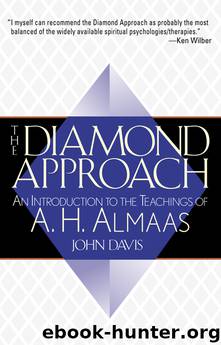The Diamond Approach by John Davis

Author:John Davis
Language: eng
Format: epub
Publisher: Shambhala Publications
CHAPTER 5
ESSENCE
THE EXPERIENCE OF the human Essence is central in the Diamond Approach. Ali calls Essence “an actual and palpable ontological presence” and points out references to it in many of the spiritual traditions. Loosely speaking, it is the human spirit. Essence is always present, but we usually fail to recognize it as such, or we experience it only in mediated, dampened ways. For instance, when we feel tenderness and caring for a friend who is suffering, the Essential quality of Compassion is arising. However, when we are identified with our personality structures, we may experience this Compassion through emotions such as pity or sorrow or through our thoughts as a kind of logical deduction about our feelings.
The experience of Essence itself, on the other hand, is direct and immediate. There is nothing between us and our experience. This immediacy and presence of Essence is deeply moving. By learning to recognize Essence, we learn to live at a depth unknown to most people. This depth of Essence is the source of an enormous richness. It is also the basis for genuine responses to the world rather than conditioned or constricted reactions. Essence cannot be adequately described in words, but the experience of Essence is unmistakable.
In his books, especially Essence, Ali goes into greater detail in discussing what Essence is not (mental images, insights, emotions, bodily sensations, intuition, or personality) as well as what it is. Concepts from psychological and spiritual traditions (including concepts from Sufism, Buddhism, Hinduism, and Taoism) are closer to Essence. It is related to the notion of energy as it is sometimes used in Hinduism (the chakra system), in Sufism (the Lataif, or subtle centers), and in Reichian and bioenergetic psychology.
A handful of psychological theories have also pointed to the true nature of human being. Abraham Maslow’s peak experiences and Being-needs, Carl Jung’s archetypes, and Karen Horney’s “true self” come closer to Essence. However, none of these concepts expresses the full depth and richness of Essence.
The content of mystical experiences and spiritual emergence, the Buddhist notion of Basic Goodness, the “vision” of vision quests, Heidegger’s notion of releasement—all of these refer to experiences of Essence. When Rumi writes about “the Friend” or “the Beloved,” when Kabir writes about “the Guest,” or when Lao-tzu writes about “Tao,” they are pointing to and expressing Essence. Although Essence is not identical or interchangeable with these other concepts, it is pointing to the same true nature. Furthermore, the range of these references to Essence gives a clue to the many ways it can manifest in experience.
It is also closely related to descriptions of a subtle or spiritual substance. Essence is, in fact, often experienced as a substance with texture, density, color, taste, sound, and the like. However, it is not a physical substance, and so it would be a mistake to equate Essence with physical energy or substance. Initially, this subtle energy or substance seems secretive and esoteric. However, Essence is not intrinsically hard to experience. It is not so mysterious; it is just difficult to recognize through the veils of our personality structures.
Download
This site does not store any files on its server. We only index and link to content provided by other sites. Please contact the content providers to delete copyright contents if any and email us, we'll remove relevant links or contents immediately.
Rewire Your Anxious Brain by Catherine M. Pittman(18491)
Talking to Strangers by Malcolm Gladwell(13135)
The Art of Thinking Clearly by Rolf Dobelli(10142)
Mindhunter: Inside the FBI's Elite Serial Crime Unit by John E. Douglas & Mark Olshaker(9107)
Becoming Supernatural by Dr. Joe Dispenza(8040)
Change Your Questions, Change Your Life by Marilee Adams(7567)
The Road Less Traveled by M. Scott Peck(7475)
Nudge - Improving Decisions about Health, Wealth, and Happiness by Thaler Sunstein(7461)
The Lost Art of Listening by Michael P. Nichols(7360)
Mastermind: How to Think Like Sherlock Holmes by Maria Konnikova(7164)
Enlightenment Now: The Case for Reason, Science, Humanism, and Progress by Steven Pinker(7085)
Win Bigly by Scott Adams(7033)
The Way of Zen by Alan W. Watts(6452)
Daring Greatly by Brene Brown(6369)
Big Magic: Creative Living Beyond Fear by Elizabeth Gilbert(5557)
Grit by Angela Duckworth(5449)
Ego Is the Enemy by Ryan Holiday(5228)
Men In Love by Nancy Friday(5114)
Altered Sensations by David Pantalony(5006)
